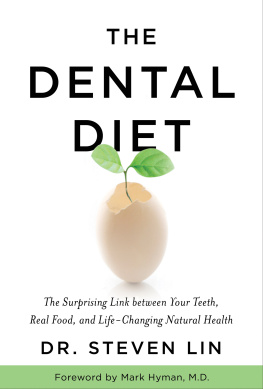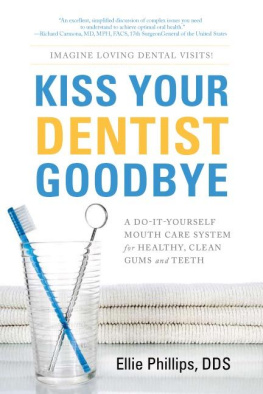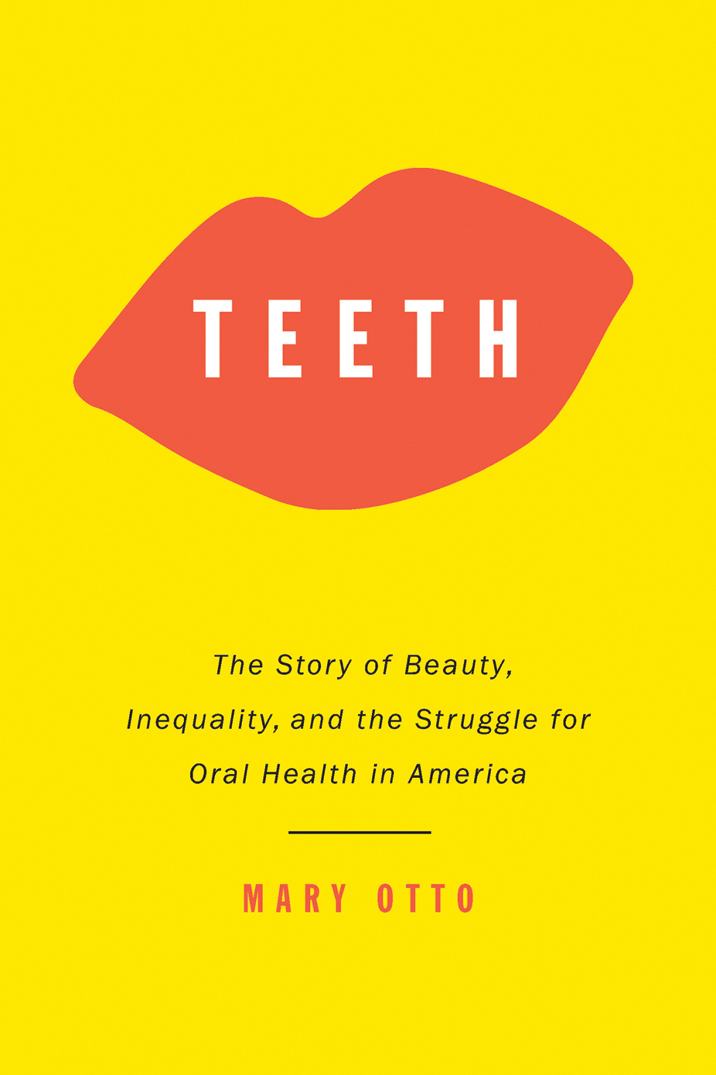
2017 by Mary Otto
All rights reserved.
No part of this book may be reproduced, in any form, without written permission from the publisher.
Requests for permission to reproduce selections from this book should be mailed to: Permissions Department, The New Press, 120 Wall Street, 31st floor, New York, NY 10005.
Published in the United States by The New Press, New York, 2016
Distributed by Perseus Distribution
LIBRARY OF CONGRESS CATALOGING-IN-PUBLICATION DATA
Names: Otto, Mary, author.
Title: Teeth: the untold story of beauty, inequality, and the struggle for oral health in America / Mary Otto.
Description: New York: New Press, 2016. | BeautySufferingEmergenciesThe world beneath our nosesThe birth of American dentistrySeparate livesAdventurers and auxiliariesThe systemColor lines Deamontes worldRiding into the epidemicSons and daughters of Chapin Harris. | Includes bibliographical references and index.
Identifiers: LCCN 2016041484 (print) | LCCN 2016043002 (ebook) | ISBN 9781620972816 (e-book)
Subjects: | MESH: Dental Careeconomics | Healthcare Disparities | Tooth Diseasescomplications | Dental Carehistory | Poverty | Health Policy | United States
Classification: LCC RK58.5 (print) | LCC RK58.5 (ebook) | NLM WU 29 | DDC 617.600973dc23
LC record available at https://lccn.loc.gov/2016041484
The New Press publishes books that promote and enrich public discussion and understanding of the issues vital to our democracy and to a more equitable world. These books are made possible by the enthusiasm of our readers; the support of a committed group of donors, large and small; the collaboration of our many partners in the independent media and the not-for-profit sector; booksellers, who often hand-sell New Press books; librarians; and above all by our authors.
www.thenewpress.com
Book design and composition by Bookbright Media
This book was set in Bembo and Oswold
Printed in the United States of America
10 9 8 7 6 5 4 3 2 1
Contents
Table of Contents
Guide
AIDA BASNIGHT STOOD ON A WINTRY STREET CORNER IN DOWNTOWN Washington, D.C. She was dressed in a bright, hand-knit hat and scarf and a heavy coat. She was working to sell a newspaper produced by the citys homeless. There was solemn beauty in her dark eyes, in her high cheekbones, in her smooth skin, but she was careful to smile with her mouth closed.
Her missing teeth bore testimony to her lifes hardships.
Her molars had been the first to go. She lost them to infection in her thirties when she was working as a secretary in Chicago. She woke up in terrible pain with a swollen face, and the molars were extracted. Amid other difficulties, other teeth went bad.
When she was in her mid-fifties she lost a steady job working with computers. Then she fell behind on her rent and lost her home. She slept in a park for a while. Its really scary being out there in the street and being homeless, she said.
She eventually found help through a womens supportive housing program. But Basnight, who always prided herself on her work ethic and skills, had been unable to find a lasting job, in spite of dozens of applications. Nobodys gonna hire you with that bunch of gaps in your teeth, her elderly mother warned her. Basnight feared her mother was right. I always feel self-conscious about them in the interviews. I cant smile because Ive got no teeth.
She said she kept hoping for something better. But in the meantime she stood in the cold with her newspapers, facing the well-dressed commuters. They hurried past her, toward the rush-hour trains.
Shame is common among the millions of Americans who lack dental care. More than one out of three low-income adults avoids smiling, according to a Harris poll conducted on behalf of the American Dental Association in 2015.
Americas social welfare programs continually emphasize the importance of self-advancement, but, lacking dental care, the poor and working poor find it especially difficult to improve their lives. In the competition for service jobs, working at restaurants or retail counters or reception desks, they are often passed over. Unless they look good, you dont want to hire them, observed dentist Judith Allen, who spends her days working with poor and uninsured patients in a city health department clinic in Cincinnati, Ohio.
When patients get to Allen they are often in pain. Their lips and even eyes may be swollen by oral infections. Their teeth are diseased and ruined. Many have gone for so long without dental care, extraction is the only option. We remove what we cant save. And then we go in and we restore what we have left. Without her help their teeth will continue to mark them as broken people. And across the country, millions go without help. There is a shortage of places like the Cincinnati clinic where Allen works.
Stigma is an ancient word: a brand or mark of subjection or disgrace. In the way that they disfigure the face, bad teeth depersonalize the sufferer. They confer the stigma of economic and even moral failure. People are held personally accountable for the state of their teeth in ways that they are not held accountable for many other health conditions.
There has been a scarcity of sociological research on this subject, but a team of British researchers looked at the phenomenon. Although tooth decay and gum disease involve diseased tissue, those experiencing these physical states are not generally regarded as being ill, observed the author of their study. In part, this may be because oral health problems are seen as a failure of individual responsibility rather than misfortune.
In the study, participants, who lost their teeth through disease and trauma, discussed their feelings. Its almost as if I feel as if Ive failed because Ive got dentures, said one woman. I dont think people feel the same way about knee replacements, do they? responded the researcher. No, thats right, the woman said.
For reasons including poverty, isolation, and the lack of private insurance and providers available to treat the poor, roughly one-third of the people living in America face significant barriers to obtaining dental care. Medicaid, the federal-state health program that now covers more than 72 million poor Americans, treats adult dental benefits as optional. It is up to states to decide whether to offer them. In hard times, coverage of even the most basic dental procedures often ends up on state chopping blocks.
The young and the old also suffer. More than 35 million poor children are entitled by federal law to dental benefits under Medicaid, but more than half go without care. Fewer than half the nations roughly one hundred fifty thousand working dentists participate in the program. Only a tiny fraction work in federally funded safety net clinics. Approximately 49 million Americans live in communities that are federally designated as dental professional shortage areas. Medicare, the federal health care program that currently provides benefits to more than 55 million aged and disabled people, has never included coverage for routine dental care.
In the seventeenth century, French philosopher Ren Descartes introduced a theory that changed the world. He uncoupled the indivisible spiritual human mind from the divisible working machinery of the human anatomy, thus liberating scientific inquiry from religious dogma. He also, it could be said, removed the head from the body.
In the wake of Descartes, increasingly specialized healers began laying claim to parts of the body for study and treatment. For centuries, along with shaving and tonsuring, leeching and cupping, barber surgeons had counted tooth extractions among the deeply personal services they performed. But the teeth were worthy of science too, Pierre Fauchard, the eminent eighteenth-century surgeon-dentist, insisted. He advanced the idea that dentistry was a unique and important branch of surgery.





![Ramiel Nagel - Cure Tooth Decay: Remineralize Cavities and Repair Your Teeth Naturally with Good Food [Second Edition]](/uploads/posts/book/53583/thumbs/ramiel-nagel-cure-tooth-decay-remineralize.jpg)

